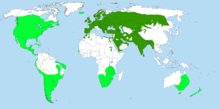Old World sparrow
![]()
Sperling is a redirect to this article. For other meanings, see Sparrow (disambiguation).
The sparrows (Passeridae, from Latin passer, "sparrow") are a family of birds belonging to the songbirds.
A total of eight genera with 43 species are counted to this family. The word "sparrow" is derived from the Old High German sparo (Middle High German then spar 'wriggle') with the suffix -ling. Their distribution is predominantly Eurasia and Africa, with Africa being the distribution focus. A few representatives of this genus have also been introduced to other continents. For example, the house sparrow (Passer domesticus), also known as the sparrow, is found in large parts of North America and South America after European settlers deliberately introduced it there. The house sparrow is now also widespread in Australia and New Zealand.
In Central Europe, the tree sparrow (Passer montanus) occurs. Somewhat less well known is the southern European willow sparrow (Passer hispaniolensis). The snow sparrow (Montifringilla nivalis), formerly called snow finch, from the high altitudes of the Alps also belongs to the sparrows. In Africa, the grey-headed sparrow is one of the most common sparrow species.
In Germany, the house sparrow was bird of the year in 2002.
In the past, a part of mankind went against sparrows in several so-called sparrow wars.
,_one_in_flight.jpg)
Damara Sparrows

Distribution of Passer domesticus, dark green = natural or original distribution, light green = secondary distribution.
Appearance
Sparrows are small songbirds that typically reach a body length between 10 and 20 centimeters. They are compactly built birds with a large head relative to body size and a short, strong bill that tapers to a point at the front. In some species, the bill color changes from horned to black during the breeding season. The tail is relatively short in most species and either ends in a straight line or is somewhat notched, always consisting of twelve control feathers.
The plumage is brown, grey or reddish-brown in most species. Only a few species also have yellow or white plumage. In some species there is a pronounced sexual dimorphism, but in other species there is no sex-specific difference in plumage colouration. Young birds resemble the adult female.
Adult sparrows undergo a full moult once a year, starting after the last brood. Young birds moult within the first month after they have fledged.

Sexual dimorphism in the house sparrow
Habitat and way of life
Sparrows prefer open, dry or semi-arid regions as habitat. They also occur in savannahs, scrublands and deserts. They are also found in sparse forests as well as on agricultural land and in or near human settlements. Some species, such as the house sparrow, live in close proximity to humans and are also found in the inner city areas of larger towns.
Most sparrow species nest in loose colonies, with only a few species breeding singly. Colonies can be very large: In Morocco in the 1950s, a breeding colony of the willow sparrow was observed to have about 125,000 nests on 60 hectares. This included up to 50 nests in a single tree. However, reports of breeding colonies of such size are the exception: it was not until the 1980s that a breeding colony of willow sparrows with 4,678 nests was counted again in Algeria. At that time, a total of 35,000 pairs of willow sparrows were breeding in 13 colonies in an area covering 40,000 square kilometres. This meant that there were 0.9 breeding pairs per square kilometre.
Sparrows are usually monogamous, a few species enter into a pair relationship that lasts as long as both partners are alive. Regardless of the location of the nest, it is in principle always a spherical nest with a lateral entrance. The nest is usually not built very carefully, the nesting material, which is not worked on the outside, usually hangs down loosely. Some species also use abandoned nests of other bird species. Both parent birds breed and are involved in rearing the young.
The sparrows have a very distinct hierarchy within their colonies. This is determined by the size of their characteristic dark bibs; the larger and darker the bib, the higher the rank of the bird within its colony.
Sparrows often engage in an interesting form of plumage care called dust bathing or sand bathing. To do this, they squat in a hollow of dry sand and dust and display a conspicuous behaviour in it, in which the body is pressed to the ground and then moved briskly back and forth. This is a hygienic behaviour with the aim of getting rid of parasites in the plumage, such as feather mites.
Questions and Answers
Q: What is a sparrow?
A: A sparrow is a member of the genus Passer, which are small passerine birds that belong to the family Passeridae.
Q: Where do sparrows often make their nests?
A: Sparrows often make their nests near houses or buildings, making them one of the easiest birds to see in the wild.
Q: How many species of sparrow are there around the world?
A: There are about 30 species of sparrow around the world.
Q: What is the best known species of sparrow?
A: The best known species of sparrow is the house sparrow, Passer domesticus.
Q: Are there any other genera that are sometimes considered part of the sparrow group?
A: Yes, some authorities place other genera in the sparrow group such as Petronia (rock sparrows), Carpospiza (pale rockfinch), and Montifringilla (snowfinches).
Search within the encyclopedia